
Biomechanical engineer Robert Armiger and surgical roboticist Carol Reiley, both of Johns Hopkins University, created Air Guitar Hero as a fun rehabilitation exercise for people with amputations. The original version they made was a bit costly, but they wrote up a less expensive DIY version, and shared their build instructions with us on the pages of MAKE Volume 29. Now we’ve shared the full how-to on Make: Projects. Whether you intend to build your own or use the concepts to build something entirely different, the info is freely available for you to play with.
How does it work?
When a muscle contracts or flexes, it produces electrical activity. While faint (in the millivolt range), these signals can be detected by placing electrode sensors on the skin. The technology to measure, evaluate, and process muscular electricity is called electromyography (EMG). Air Guitar Hero uses EMG to send signals to the Wii console to control the game. But since the electrical signal generated by twiddling your fingers is very weak, additional computation must be performed to generate reliably accurate commands. The system uses pattern recognition algorithms to identify patterns in the EMG signals and decide which colored button to activate. The algorithms require training data to provide examples of what signal characteristics to look for. First, you must correctly play on-screen notes with the guitar while the electrodes record your EMG signals. Next, the recorded data is used to train a model for recognition the next time you make those movement patterns. Third, practice makes perfect! Playing this type of video game can be useful for building muscle tone and dexterity.
You play air guitar, moving your (A) 4 fingers corresponding to the first 4 “note” buttons on the Guitar Hero controller. (B) Electrodes on your arm detect tiny electrical signals from the muscles that move your fingers. These (C) EMG signals are boosted by (D) amplifiers, each on their own channel. The amplified signals are gathered by the (E) data acquisition board, which sends them on to the (F) laptop computer. The (G) USB video capture device pulls the Guitar Hero video from the (H) Wii video game console into the computer, for purposes of training the software. The (I) Air Guitar Hero software interprets the mixture of EMG signals as one of the 4 button-pressing motions, then sends the corresponding button command over to the (J) hacked GH controller which relays it to the Wii. It sends the Strum command automatically when you hit the note. You’re rocking out!
Here’s a video of Iraq war veteran amputee and Open Prosthetics Project founder Jon Kuniholm demoing the Air Guitar Hero:
From the pages of MAKE Volume 29:
We have the technology (to quote The Six Million Dollar Man), but commercial tools for exploring, assisting, and augmenting our bodies really can approach a price tag of $6 million. Medical and assistive tech manufacturers must pay not just for R&D, but for expensive clinical trials, regulatory compliance, and liability — and doesn’t help with low pricing that these devices are typically paid for through insurance, rather than purchased directly. But many gadgets that restore people’s abilities or enable new “superpowers” are surprisingly easy to make, and for tiny fractions of the costs of off-the-shelf equivalents. MAKE Volume 29, the “DIY Superhuman” issue, explains how.
2 thoughts on “Rock Out Hands Free with Air Guitar Hero”
Comments are closed.
ADVERTISEMENT
Join Make: Community Today













[…] ser consideradas como propias de la ciencia ficción. Este es el ejemplo y caso que nos ocupa, un sistema llamado Air Guitar Hero. Es algo más que el clásico “air guitar” que tantas veces hemos practicado en los […]